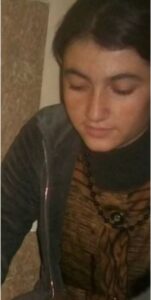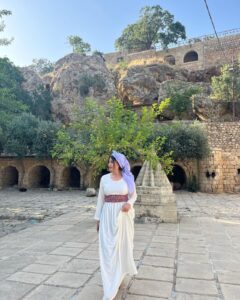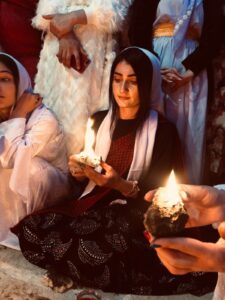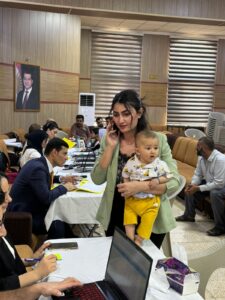Karwan Haji
Iman Abdullah Abbas, a girl from Tal Qasab village (15km south of Sinjar), was only 13 years old when ISIS invaded Sinjar on August 3, 2014. From that age, Iman faced the horrors and instability that befell the people of that region.

Iman, after being liberated from ISIS
She was still in the spring of her life when ISIS attacked Sinjar. Iman says, “I didn’t know what terrorism and killing meant. Suddenly, we saw people running towards Mount Sinjar. We also ran towards Mount Sinjar, but when we reached the beginning of the mountain, I couldn’t climb up and we returned. During our return, I saw horrific scenes.”
When ISIS entered Sinjar, “they kidnapped us and separated everyone. Along with 500 Yazidi girls, they took us to Mosul. I witnessed ISIS kill someone before my eyes – I still remember it and don’t want to recall that horrible scene.”
ISIS emirs would come to where they were kept and trade the girls. A Sinjar girl named Jilan killed herself out of fear. Separated from her family, Iman recalls how all ISIS emirs demanded they change their religion. They were then taken to an ISIS emir’s place where they became shepherds for his livestock for five months.
Later, the Office for Yazidi Abductee Affairs in Duhok rescued her after three days and thirty nights of walking.

Iman visits the Lalish temple after being liberated from ISIS
Iman says in her story, “I never believed I would reintegrate into society, but when I came among people, I saw they looked at me with respect, which gave us strength and good morale. Now I speak Arabic and English well and have attended international conferences supporting Yazidi girls.”
While Iman’s story reveals lasting memories of these events, she also talks about her future and transforming her life. Iman isn’t just a survivor of a tragic story; she’s also an admirable example of community healing. She has fully developed her potential as a young, intelligent woman and has become a source of inspiration for other victims from her village.
The events show how Iman and others like her offered their strength through actions to rebuild their lives during displacement. The key point in this story is how Iman and her friends managed to rise from past tragedies and reorganize themselves.

Iman lights a candle at the Lalish temple
Currently, Iman strives to convey the voice of her and her friends’ broken experiences through participation in social and political activities. She tries to help other survivors by presenting victims’ demands and supporting aid projects.
Iman has also participated in conferences and activities promoting peace and human rights. She continuously tries to convey the voice of victims and support all those who survived ISIS.

Now the manager of the project distributing financial grants to Yazidi survivors
During the five months after their rescue, Iman still struggled to adapt to camp life and receive psychological support. For three months, she couldn’t leave her tent and go outside, sometimes feeling afraid. However, with time and support from those around her, Iman managed to adapt and dedicate herself to activities and social work.
Iman didn’t stop there – until a special office was opened by the Kurdistan Regional Government in Duhok to support and assist ISIS survivors’ return, Iman became the office manager. She says,
“I’m very happy now to help the same people who experienced the illness I did.
I hope I can serve ISIS survivors as long as I live.”

